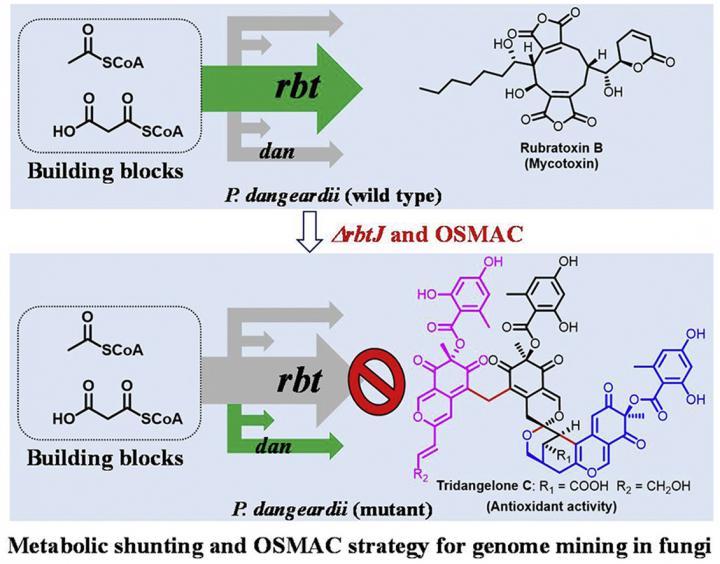
Credit: Acta Pharmaceutica Sinica B
Genome mining combined metabolic shunting and OSMAC strategy of an endophytic fungus leads to the production of diverse natural products
Endophytic fungi are promising producers of bioactive small molecules. Bioinformatic analysis of the genome of an endophytic fungus Penicillium dangeardii revealed 43 biosynthetic gene clusters, exhibited its strong ability to produce numbers of secondary metabolites. However, this strain mainly produce rubratoxins alone with high yield in varied culture conditions, suggested most gene clusters are silent. Efforts for mining the cryptic gene clusters in P. dangeardii, including epigenetic regulation and one-strain-many-compounds (OSMAC) approach were failed probably due to the high yield of rubratoxins. A metabolic shunting strategy by deleting the key gene for rubratoxins biosynthesis combining with optimization of culture condition successfully activated multiple silent genes encoding for other polyketide synthases (PKSs), and led to the trace compounds detectable. As a result, the authors were able to identify a total of 23 new compounds including azaphilone monomers, dimers, trimers with unprecedented polycyclic bridged heterocycle and spiral structures, as well as siderophores. Some compounds showed significant cytotoxicities, anti-inflammatory or antioxidant activities. The attractive dual PKSs gene clusters for azaphilones biosynthesis were mined by bioinformatic analysis and overexpression of a pathway specific transcription factor. This research provides an efficient approach to mine the chemical diversity of endophytic fungi.
###
Article reference: Qian Wei, Jian Bai, Daojiang Yan, Xiuqi Bao, Wenting Li, Bingyu Liu, Dan Zhang, Xiangbing Qi, Dequan Yu, Youcai Hu, Genome mining combined metabolic shunting and OSMAC strategy of an endophytic fungus leads to the production of diverse natural products, Acta Pharmaceutica Sinica B, 2021, ISSN 2211-3835, https:/
Keywords: Endophytic fungi; Penicillium dangeardii; Genome mining; Silent gene cluster; Azaphilones; Trimers; Metabolic shunting
The Journal of the Institute of Materia Medica, the Chinese Academy of Medical Sciences and the Chinese Pharmaceutical Association.
Acta Pharmaceutica Sinica B (APSB) is a monthly journal, in English, which publishes significant original research articles, rapid communications and high-quality reviews of recent advances in all areas of pharmaceutical sciences — including pharmacology, pharmaceutics, medicinal chemistry, natural products, pharmacognosy, pharmaceutical analysis and pharmacokinetics.
For more information please visit https:/
Editorial Board: https:/
APSB is available on ScienceDirect.
Submissions to APSB may be made using Editorial Manager®.
CiteScore: 10.5
Impact Factor: 7.097
5-Year Impact Factor: 7.865
Source Normalized Impact per Paper (SNIP): 2.210
SCImago Journal Rank (SJR): 1.792
ISSN 2211-3835
Media Contact
Morgan lyons
[email protected]
Related Journal Article
http://dx.




